Leakage Fault Diagnosis of Wind Tunnel Valves Using Wavelet Packet Analysis and Vision Transformer-Based Deep Learning
Abstract
1. Introduction
2. Research Framework and Workflow
- Select an appropriate wavelet packet system and extract sub-band energy features from sensor signals.
- Construct diagnostic indicators based on sub-band energy ratios.
- Develop a finite element model of the valve system to validate the sensitivity of the features.
- Build a comprehensive database integrating simulated data.
- Train and evaluate deep learning models (ViT, SwinT, ResNet, and GoogLeNet) using standard evaluation metrics.
- Compare the performance of the models and identify the most effective diagnostic approach.
3. Principle of Wavelet Decomposition
3.1. Basic Concept of Wavelet Transform
3.2. Signal Processing and Analysis
4. Vibration Monitoring and Leakage Fault Diagnosis of Pneumatic Pressure Regulating Valve
4.1. Sensors Arranged Along the Length Direction of the Valve
4.2. Sensors Arranged Along the Circular Direction
5. Numerical Simulations of Pressure Regulating Valve Leakage Failure
6. Leakage Fault Diagnosis Based on Vision Transformer
6.1. Vision Transformer
6.2. Input Representation and Workflow
- Signal preprocessing and normalization.
- Patch creation and embedding.
- Feeding embedded sequences into the ViT encoder with multi-head self-attention.
- Classification of patches to predict leakage locations.
6.3. Database Construction
6.4. Training Strategy
6.5. Model Accuracy
6.6. Prediction Reliability
7. Conclusions
- A comprehensive vibration monitoring scheme for an annular gap type pressure-regulating valve in a 1.2 m transonic wind tunnel was established. Acceleration sensors were deployed at multiple locations to capture non-stationary signals, and wavelet packet decomposition effectively separated low- and high-frequency features, providing a reliable basis for leakage fault diagnosis.
- The maximum component energy index, derived from wavelet packet analysis, accurately identified leakage locations. For sensors along the valve’s longitudinal direction, the maximum energy fractions of sensors No. 1 and No. 2 reached 64.88% and 64.48%, respectively, while among circularly arranged sensors, sensor No. 2 recorded 87.85%, all consistent with the actual leakage points.
- The variation rate of maximum component energy served as a highly sensitive indicator in numerical simulations. Circular nodes 2, 7, and 8 exhibited significantly higher variation rates of 6.93%, 7.33%, and 7.9%, respectively, aligning well with the actual leakage positions and demonstrating the robustness of this metric for fault detection.
- The ViT model, trained on a dedicated database covering multiple leakage scenarios and sensor arrangements, achieved rapid and fully accurate classification of valve leakage conditions (up to 100% in the current case). Compared with SwinT, ResNet, and GoogLeNet, ViT demonstrated superior training efficiency, prediction accuracy, and reliability, providing a robust, automated, and practical approach for leakage fault diagnosis in wind tunnel valves, ultimately enhancing operational monitoring, maintenance, and safety.
- (1)
- Expanding the database with real experimental measurements under diverse operating conditions.
- (2)
- Evaluating the framework on different valve types and more complex wind tunnel configurations.
- (3)
- Investigating multimodal sensor integration and adaptive learning strategies to enhance practical applicability and robustness.
Author Contributions
Funding
Data Availability Statement
Conflicts of Interest
References
- Li, Y.; Zheng, S.; Shang, Z.; Chen, J.; Wang, D. Experimental study on the seismic behavior of ECE corroded reinforced concrete short pier columns. Constr. Build. Mater. 2022, 348, 128681. [Google Scholar] [CrossRef]
- Li, Y.; Sun, Z.; Li, Y.; Zhu, W.; Zheng, H.; Zheng, S. Exploring the shear performance and predictive shear capacity of corroded RC columns utilizing the modified compression-field theory: An investigative study. Eng. Struct. 2024, 302, 117390. [Google Scholar] [CrossRef]
- Li, Y.; Sun, Z.; Li, Y.; Dong, J.; He, W. Time-dependent combined index seismic resilience assessment of shear-critical RC bridge piers with height-varying corrosion. Eng. Struct. 2024, 308, 117957. [Google Scholar] [CrossRef]
- Zhang, J.P.; Yan, H.C.; Feng, G.W.; Wang, X.L. Research on Active Maintenance Expert System for Regulating Valve Failures. Process Autom. Instrum. 2020, 41, 22–25. [Google Scholar]
- Zheng, K.Y.; Chen, Z. Investigation of Qualification Test of Class 1E Electric Actuator for Valves in Generation III Passive Nuclear Power Plants. Nucl. Saf. 2018, 17, 52–57. [Google Scholar]
- Sun, Z.; Wang, X.; Han, T.; Wang, L.; Zhu, Z.; Huang, H.; Ding, J.; Wu, Z. Pipeline deformation prediction based on multi-source monitoring information and novel data-driven model. Eng. Struct. 2025, 337, 120461. [Google Scholar] [CrossRef]
- Sun, Z.; Wang, X.; Han, T.; Huang, H.; Wang, L.; Wu, Z. Pipeline deformation monitoring based on long-gauge FBG sensing system: Missing data recovery and deformation calculation. J. Civ. Struct. Health Monit. 2025, 15, 2433–2453. [Google Scholar] [CrossRef]
- Sun, Z.; Wang, X.; Niu, D.; Luo, D.; Han, T.; Li, Y.; Huang, H.; Wu, Z. Electrical resistivity prediction model for basalt fibre reinforced concrete: Hybrid machine learning model and experimental validation. Mater. Struct. 2025, 58, 89. [Google Scholar] [CrossRef]
- Capaci, R.B.D.; Scali, C. Review and Comparison of Techniques of Analysis of Valve Stiction: From Modeling to Smart Diagnosis. Chem. Eng. Res. Des. 2018, 130, 230–265. [Google Scholar] [CrossRef]
- Ali, S.M.; Hui, K.H.; Hee, L.M.; Leong, M.S.; Al-Obaidi, M.A.; Ali, Y.H.; Abdelrhman, A.M. A Comparative Experimental Study on the Use of Machine Learning Approaches for Automated Valve Monitoring Based on Acoustic Emission Parameters. In Proceedings of the International Conference on Mechanical, Manufacturing and Process Plant Engineering, Penang, Malaysia, 22–23 November 2017. [Google Scholar]
- Miskin, J.; Lindner, B.; Auret, L.; Dorfling, C.; Bradshaw, S. Fault Detection for Simulated Valve Faults in A High Pressure Leaching Process. IFAC-Pap. Line 2016, 49, 394–399. [Google Scholar] [CrossRef]
- Marcos, A.; Peñín, L.F.; Malikov, D.; Reichstadt, S.; Le Gonidec, S. Fault Detection and Isolation for A Rocket Engine Valve. IFAC Proc. Vol. 2013, 46, 101–106. [Google Scholar] [CrossRef]
- Pichler, K.; Lughofer, E.; Pichler, M.; Buchegger, T.; Klement, E.P.; Huschenbett, M. Fault Detection in Reciprocating Compressor Valves Under Varying Load Conditions. Mech. Syst. Signal Process. 2016, 70–71, 104–119. [Google Scholar] [CrossRef]
- Goncalves, L.F.; Schneider, E.L.; Henriques, R.V.B.; Lubaszewski, M.; Bosa, J.L.; Engel, P.M. Fault Prediction in Electrical Valves Using Temporal Kohonen Maps. In Proceedings of the 11th Latin American Test Workshop (LATW), Punta del Este, Uruguay, 28–31 March 2010. [Google Scholar]
- He, H.; Cheng, M. Method for Valve Fault Diagnosis Based on Optimized SVM-DT. Comput. Eng. Des. 2016, 37, 1932–1936. (In Chinese) [Google Scholar]
- Zhang, Z. Fault Detection and Stiction Compensation for Pneumatic Control Valve. Master’s Thesis, East China University of Science and Technology, Shanghai, China, 2015. (In Chinese). [Google Scholar]
- Zhang, H. Study on Fault Diagnosis of Multistage Reciprocating Compressor Valve Based on LM-BP Neural Network. Master’s Thesis, Donghua University, Shanghai, China, 2015. (In Chinese). [Google Scholar]
- Qi, H. Fault Diagnosis of the Nuclear Power Plant Valve Based on Neural Network Technology. Master’s Thesis, Harbin Engineering University, Harbin, China, 2012. (In Chinese). [Google Scholar]
- Sihui, C. Fault Detection and Diagnosis Method Research of Valves. Comput. Simul. 2012, 29, 216–219. (In Chinese) [Google Scholar]
- Luo, T. A Fault Detection and Diagnosis Method Research for Control Valves Based on Support Vector Machine in Air Conditioning Water System. Master’s Thesis, Chongqing University, Chongqing, China, 2016. (In Chinese). [Google Scholar]
- Guofeng, Y.; Shouyin, H. Pattern Recognition Technology in Fault Diagnosis of Electrical Safety Valve Level. Nucl. Power Eng. 2010, 31, 79–82. [Google Scholar]
- Wang, K.; Shen, T.; Wei, J.; Liu, J.; Hu, W. An intelligent framework for deriving formulas of aerodynamic forces between high-rise buildings under interference effects using symbolic regression algorithms. J. Build. Eng. 2025, 99, 111614. [Google Scholar] [CrossRef]
- Liu, J.; Zou, Z.; Gao, K.; Yang, J.; He, S.; Wu, Z. A novel digital unit cell library generation framework for topology optimization of multi-morphology lattice structures. Compos. Struct. 2025, 354, 118824. [Google Scholar] [CrossRef]
- Li, Y.; Sun, Z.; Mangalathu, S.; Li, Y.; He, W.; Xue, X. Machine learning-based full-life-cycle seismic response assessment for in-service bridge piers: Comprehensive analysis of interpretability and seismic fragility. Structures 2025, 80, 110050. [Google Scholar] [CrossRef]
- Daubechies, I. Ten Lectures on Wavelets; CBMS-NSF Regional Conference Series in Applied Mathematics; Society for Industrial and Applied Mathematics: Philadelphia, PA, USA, 1992. [Google Scholar]
- Kitada, Y. Identification of nonlinear structural dynamic systems using wavelets. J. Eng. Mech. Div. 1998, 124, 1059–1066. [Google Scholar] [CrossRef]
- Wang, Q.; Deng, X. Damage detection with spatial wavelets. Int. J. Solids Struct. 1999, 36, 3443–3468. [Google Scholar] [CrossRef]
- Pei, J.F.; Dong, X.; Huang, X.R.; Yu, Z.Y. Harmonic Wavelet Packet Analysis and LS-SVM Method of Reciprocating Pump Valve. Mach. Des. Manuf. 2015, 5, 241–245. [Google Scholar]
- Wu, P.; Ma, C. Research on Compressor Valve Fault Diagnosis Technology Based On Wavelet Packet Decomposition-KPCA-SVM. Petro-Chem. Equip. 2021, 24, 53–56. [Google Scholar]
- Zhang, J.P.; Chen, X.F. Bearing Fault Diagnosis Based on Wavelet Packet and Improved GA-BP Neural Network. Mech. Eng. 2022, 8, 17–19. [Google Scholar]
- Zhang, Y.; Wang, H.; Liu, J.; Liu, F.; Lv, X. Intelligent structural design of composite concrete-encased steel columns based on hybrid machine learning and multiobjective optimization. Struct. Concr. 2025, in press. [Google Scholar] [CrossRef]
- Zhang, Y.; Peng, J.; Wang, Z.; Xi, Z.; Liu, J.; Xu, L. Machine Learning-Assisted Sustainable Mix Design of Waste Glass Powder Concrete with Strength–Cost–CO2 Emissions Trade-Offs. Buildings 2025, 15, 2640. [Google Scholar] [CrossRef]
- Bao, X.; Xu, K.; Liu, J.; Jin, L. A physics-informed transformer model for long-sequence time-history response prediction of containment structures under mainshock-aftershock sequences. Eng. Struct. 2025, 343, 121005. [Google Scholar] [CrossRef]
- Wei, J.; Shen, T.; Wang, K.; Liu, J.; Wang, S.; Hu, W. Transfer learning framework for the wind pressure prediction of high-rise building surfaces using wind tunnel experiments and machine learning. Build. Environ. 2025, 271, 112620. [Google Scholar] [CrossRef]
- Li, Z.; Gao, K.; Wu, Z. Bio-inspired flapping wing design via a multi-objective optimization approach based on variable periodic Voronoi tessellation. Int. J. Mech. Sci. 2025, 291–292, 110160. [Google Scholar] [CrossRef]
- Li, Z.; Wu, Z. A novel multiscale design method for porous structures with tunable anisotropy: Varied-shape Voronoi tessellation. Comput. Methods Appl. Mech. Eng. 2024, 432, 117378. [Google Scholar] [CrossRef]
- Li, Z.; Chu, S.; Wu, Z. A novel bio-inspired design method for porous structures: Variable-periodic Voronoi tessellation. Mater. Des. 2024, 243, 20. [Google Scholar] [CrossRef]
- Li, Y.; Sun, Z.; Li, Y.; Yang, H.; Liu, X.; He, W. A Vision Transformer-based method for predicting seismic damage states of RC piers: Database development and efficient assessment. Reliab. Eng. Syst. Saf. 2025, 263, 111287. [Google Scholar] [CrossRef]
- Li, Y.; Guan, J.; Guo, L. Peridynamic-driven feature-enhanced Vision Transformer for predicting defects and heterogeneous materials locations: Applications of deep learning in inverse problems. Eng. Appl. Artif. Intell. 2025, 151, 110677. [Google Scholar] [CrossRef]
- Tran, V.T.; Al Thobiani, F.; Tinga, T.; Ball, A.; Niu, G. Single and combined fault diagnosis of reciprocating compressor valves using a hybrid deep belief network. Proc. Inst. Mech. Eng. Part C J. Mech. Eng. Sci. 2018, 232, 3767–3780. [Google Scholar] [CrossRef]
- Cai, Y.; Dai, X.; Xu, Z.; Hu, L.; Wen, Q.; Shi, J.; Zhong, F.; Yang, X.; Yang, J.; Zhou, H. A diesel engine valve leakage fault diagnostic method using modified VGG19 and transfer learning. Ships Offshore Struct. 2025, 1–10. [Google Scholar] [CrossRef]
- Zhang, G.; Zhang, K.; Shen, W.; Xu, G.; Lin, Y.J. Intelligent fault diagnosis of multi-way directional valves in hydraulic systems using digital twin and deep learning approaches. Mech. Syst. Signal Process. 2025, 230, 112579. [Google Scholar] [CrossRef]
- Yao, K.; Wang, Y.; Fan, S.; Fu, J.; Wan, J.; Cao, Y. Improved and accurate fault diagnostic model for gas turbine based on 2D-wavelet transform and generative adversarial network. Meas. Sci. Technol. 2023, 34, 075104. [Google Scholar] [CrossRef]
- He, K.; Zhang, X.; Ren, S.; Sun, J. Deep residual learning for image recognition. In Proceedings of the IEEE Conference on Computer Vision and Pattern Recognition, Las Vegas, NV, USA, 26 June–1 July 2016; pp. 770–778. [Google Scholar]
- Sun, Z.; Li, Y.; Yang, Y.; Su, L.; Xie, S. Splitting tensile strength of basalt fiber reinforced coral aggregate concrete: Optimized XGBoost models and experimental validation. Constr. Build. Mater. 2024, 416, 135133. [Google Scholar] [CrossRef]
- Sun, Z.; Wang, X.; Han, T.; Huang, H.; Ding, J.; Wang, L.; Wu, Z. Pipeline deformation monitoring based on long-gauge fiber-optic sensing systems: Methods, experiments, and engineering applications. Measurement 2025, 248, 116911. [Google Scholar] [CrossRef]
- Liu, Z.; Lin, Y.; Cao, Y.; Hu, H.; Wei, Y.; Zhang, Z.; Lin, S.; Guo, B. Swin transformer: Hierarchical vision transformer using shifted windows. In Proceedings of the IEEE/CVF International Conference on Computer Vision, Montreal, BC, Canada, 11–17 October 2021; pp. 10012–10022. [Google Scholar]
- Szegedy, C.; Liu, W.; Jia, Y.; Sermanet, P.; Reed, S.; Anguelov, D.; Erhan, D.; Vanhoucke, V.; Rabinovich, A. Going deeper with convolutions. In Proceedings of the IEEE Conference on Computer Vision and Pattern Recognition, Boston, MA, USA, 7–12 June 2015; pp. 1–9. [Google Scholar]
- Li, Y.; Sun, Z.; Sujith, M.; Li, Y.; Yang, H.; He, W. Seismic damage states prediction of in-service bridges using feature-enhanced Swin Transformer without reliance on damage indicators. Eng. Appl. Artif. Intell. 2025, 159, 111651. [Google Scholar] [CrossRef]
- Sun, Z.; Li, Y.; Han, T.; Su, L.; Zhu, X.; He, J.; Xie, S.; Shi, Y. Performance evaluation of hybrid fiber-reinforced concrete based on electrical resistivity: Experimental and data-driven method. Constr. Build. Mater. 2024, 446, 137992. [Google Scholar] [CrossRef]
- Tukhtaev, A.; Turimov, D.; Kim, J.; Kim, W. Feature selection and machine learning approaches for detecting sarcopenia through predictive modeling. Mathematics 2024, 13, 98. [Google Scholar] [CrossRef]

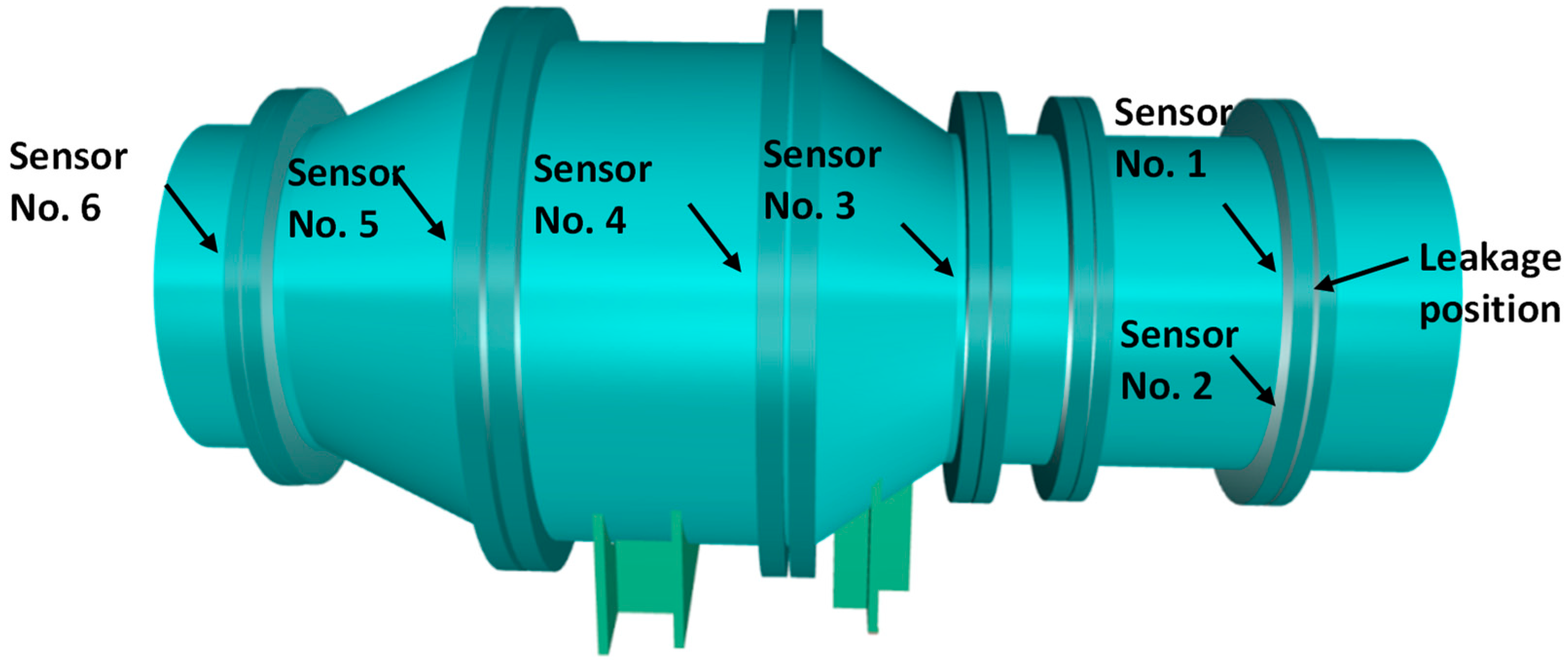

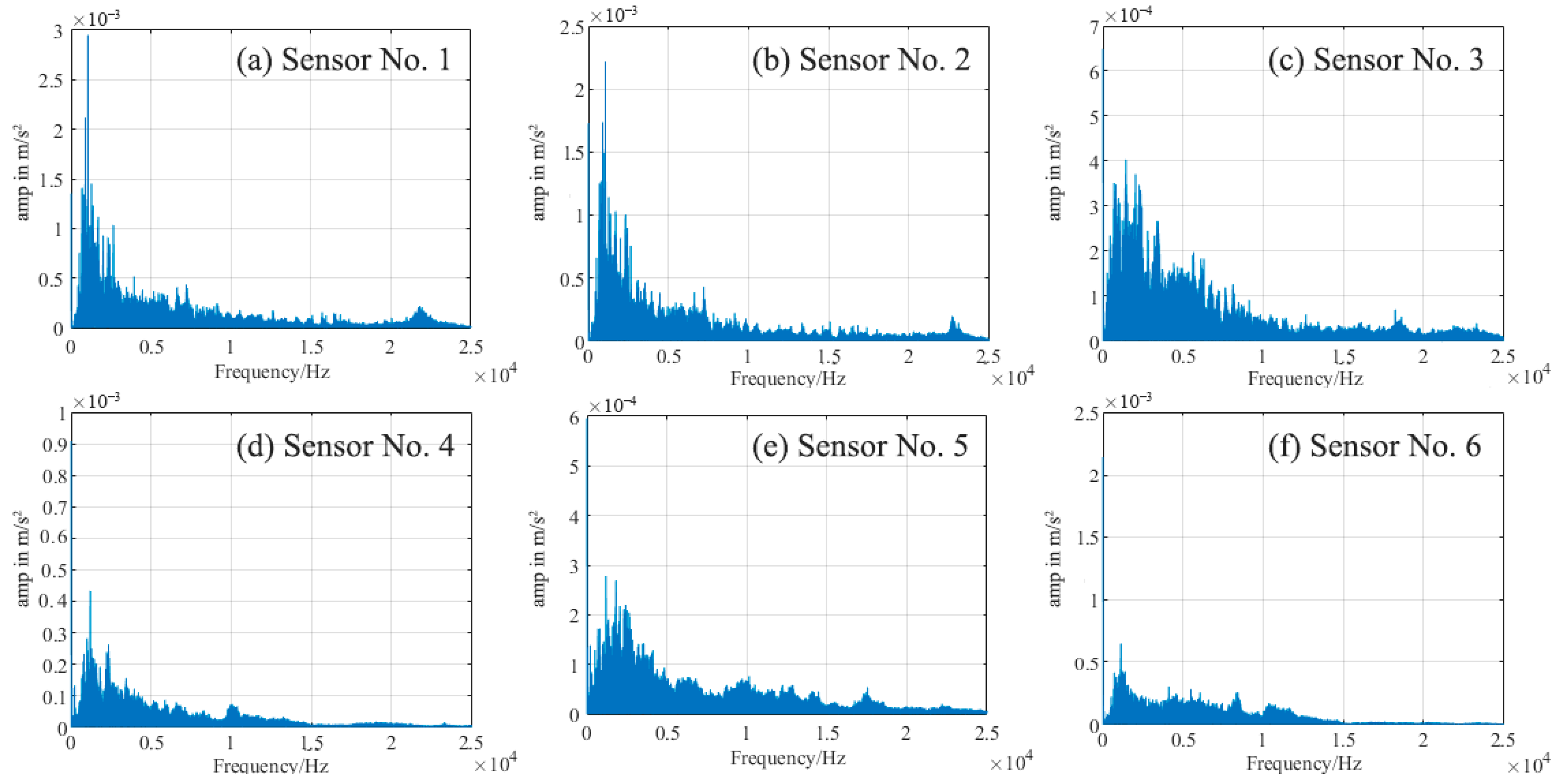
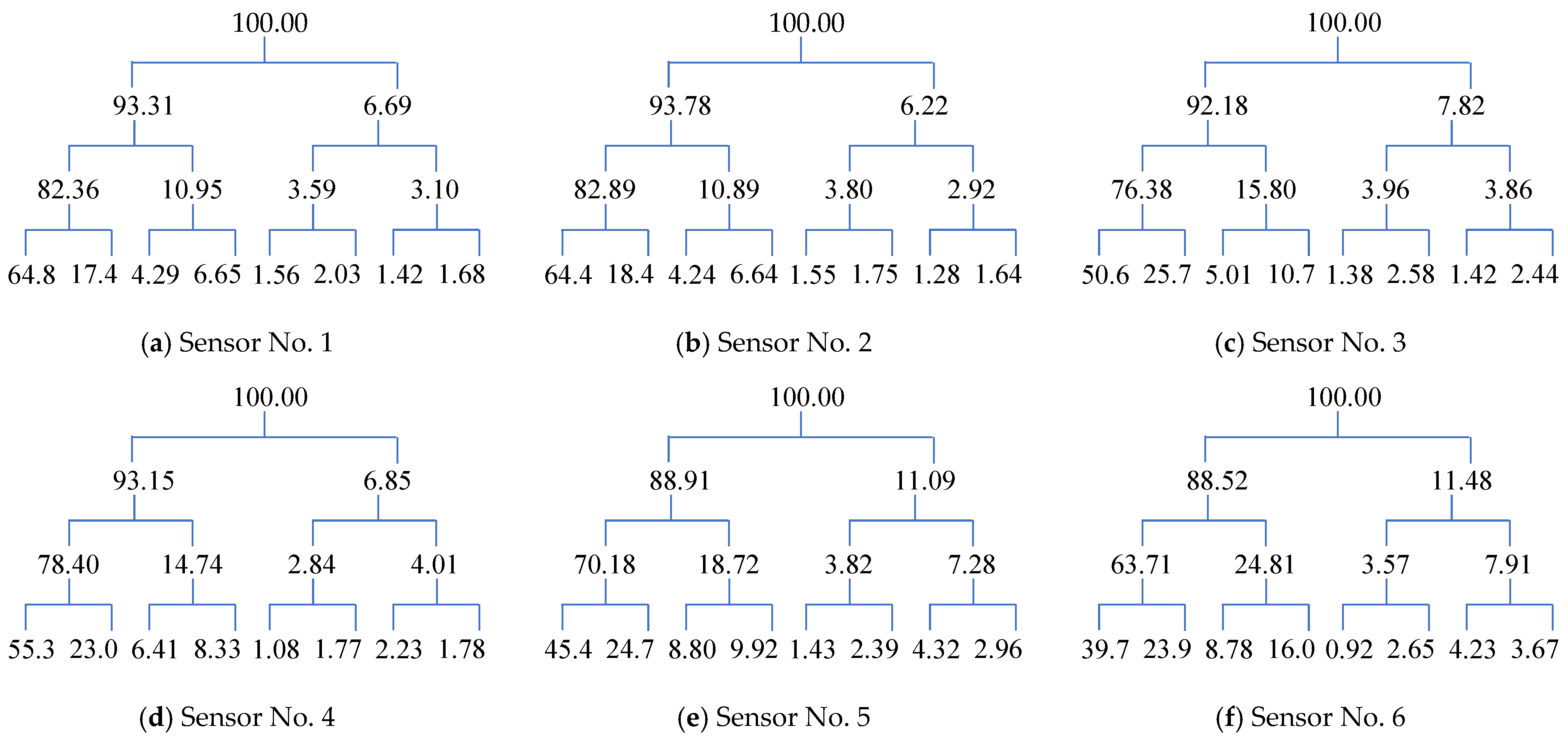
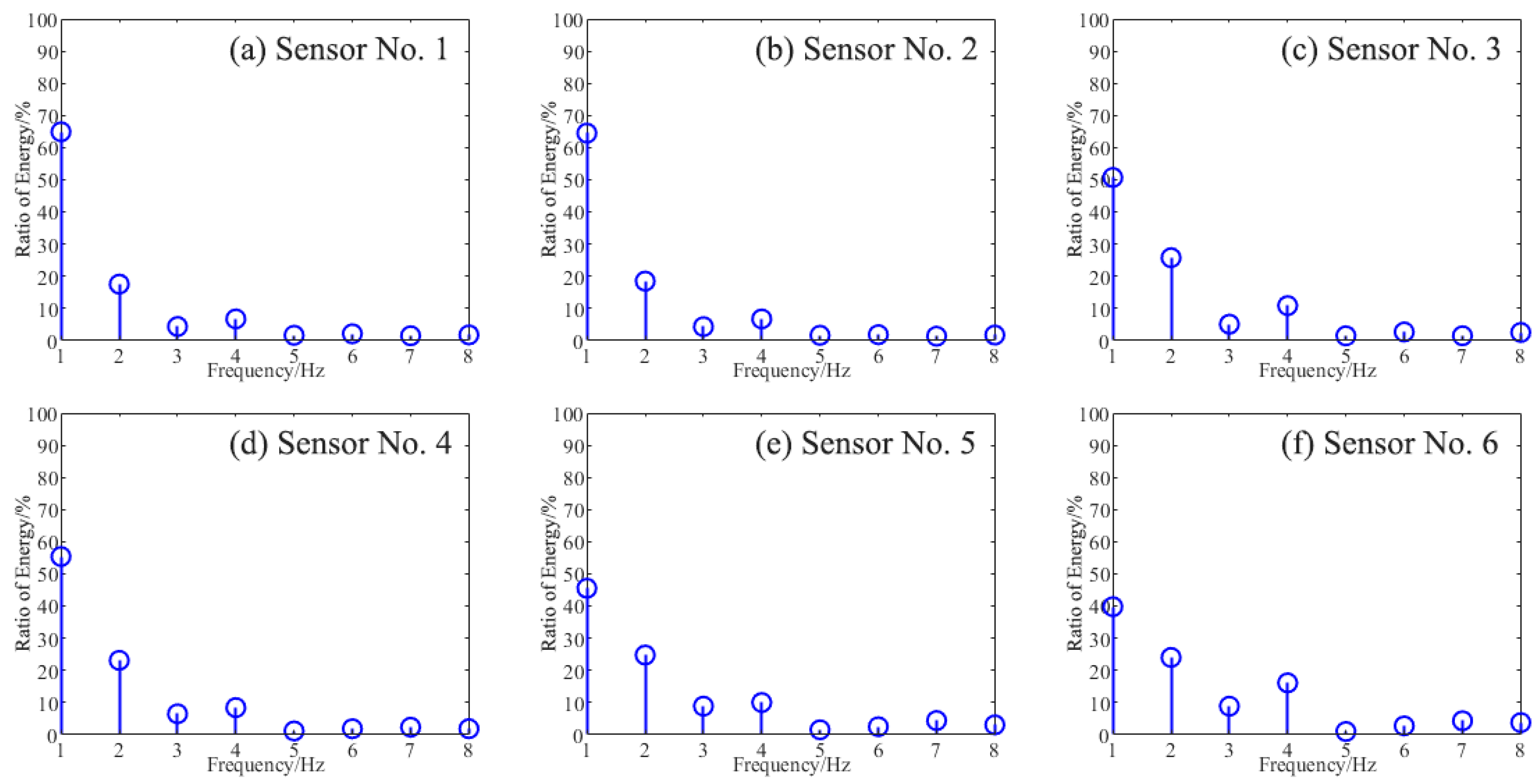

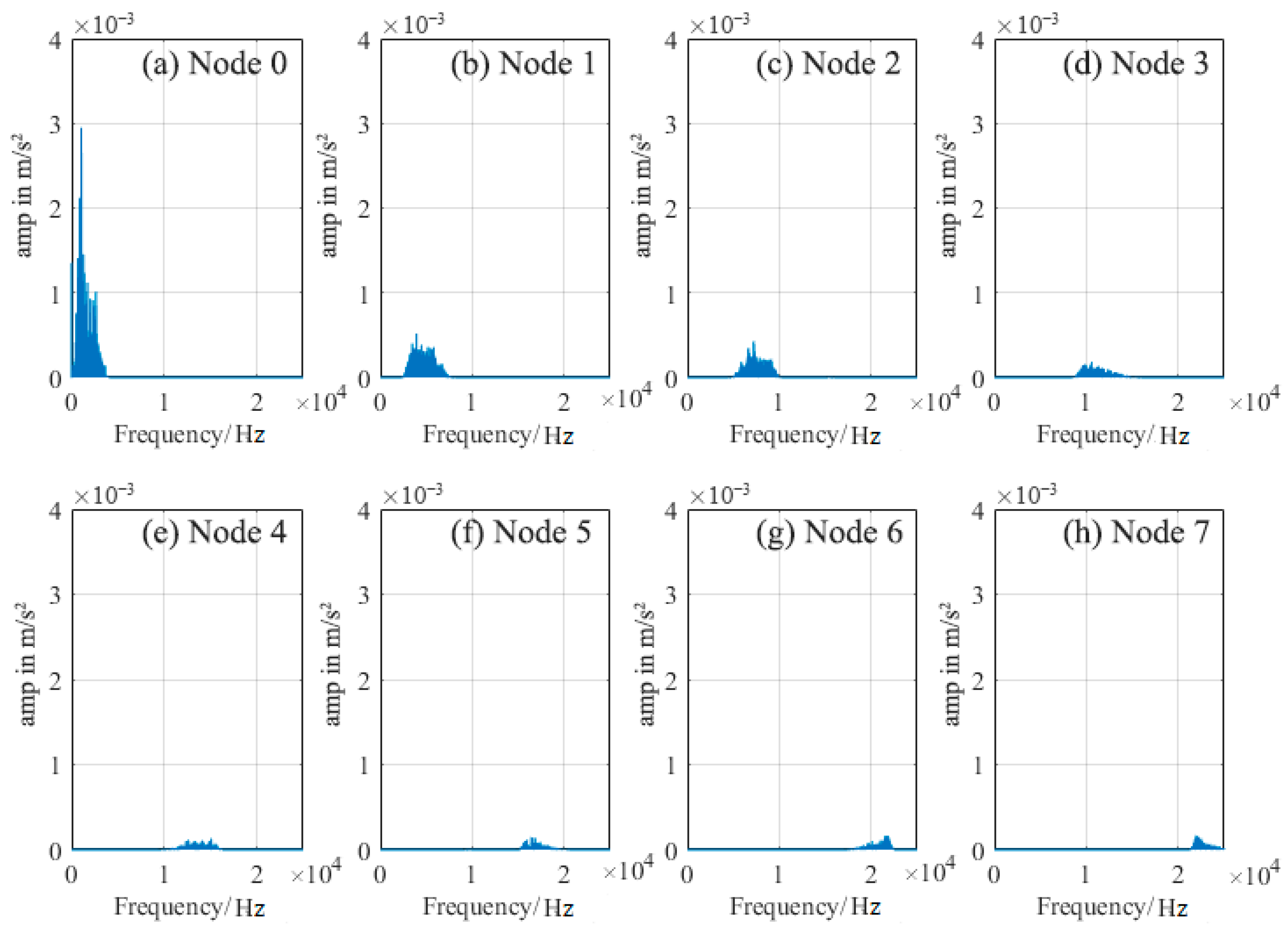
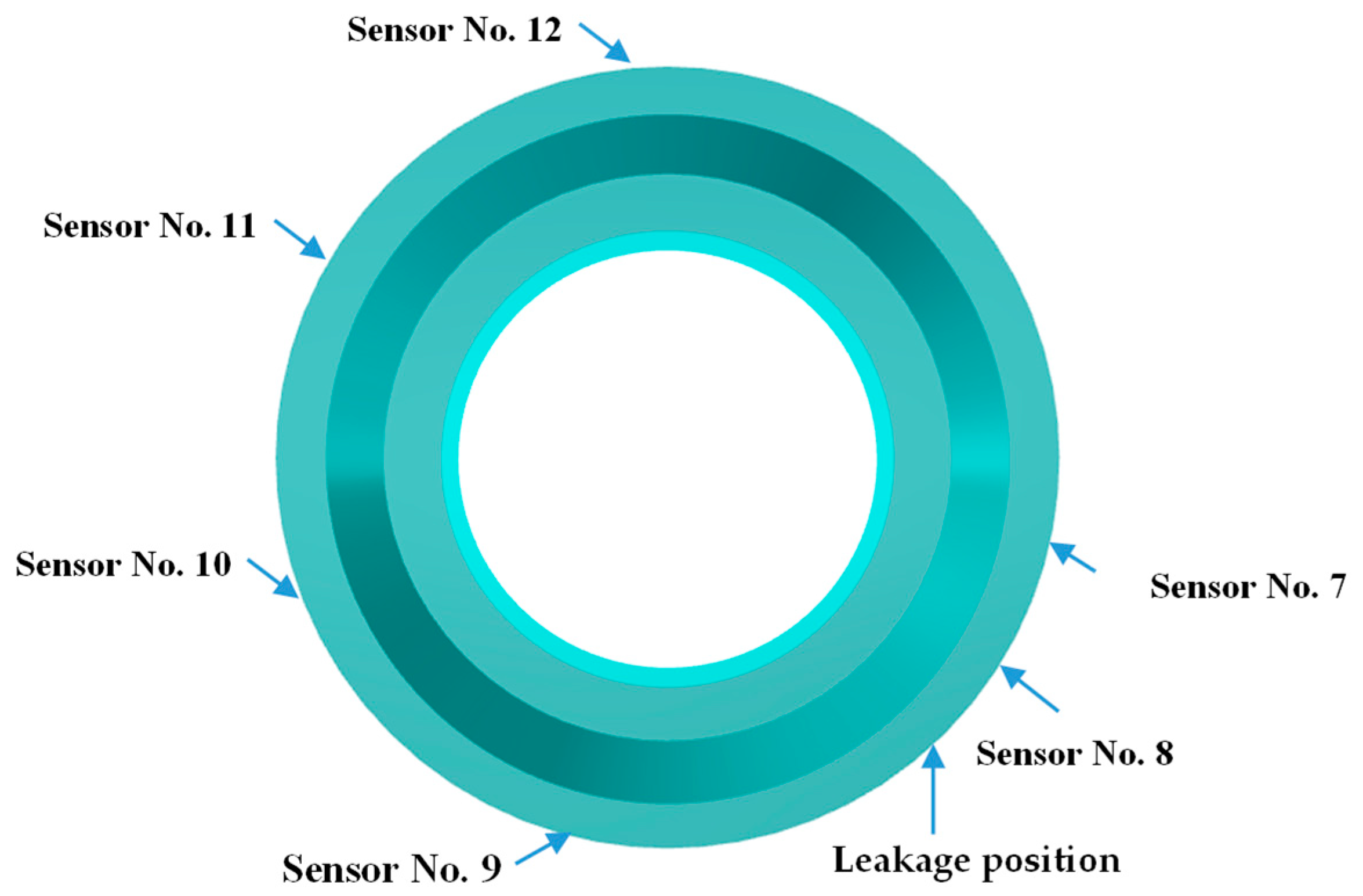

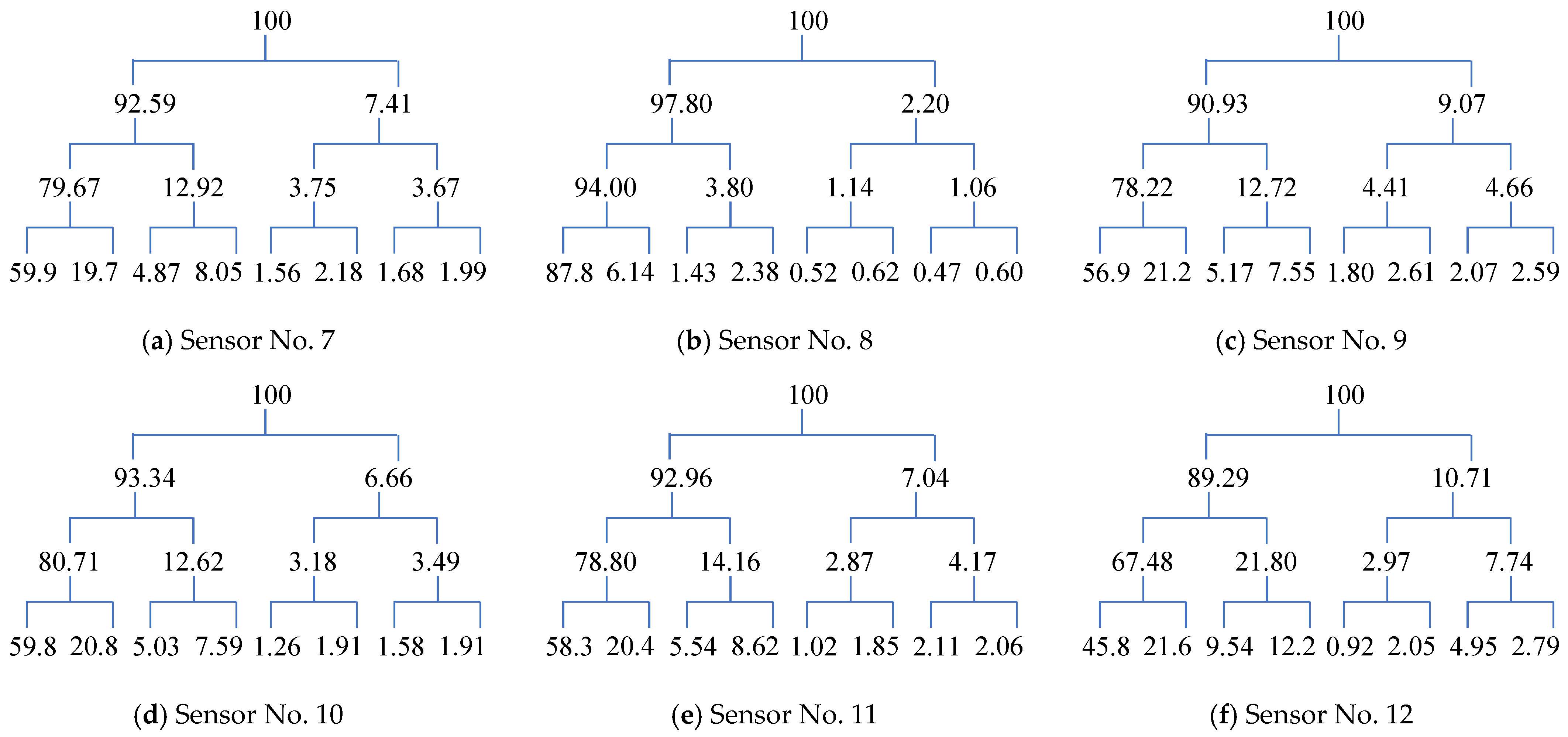
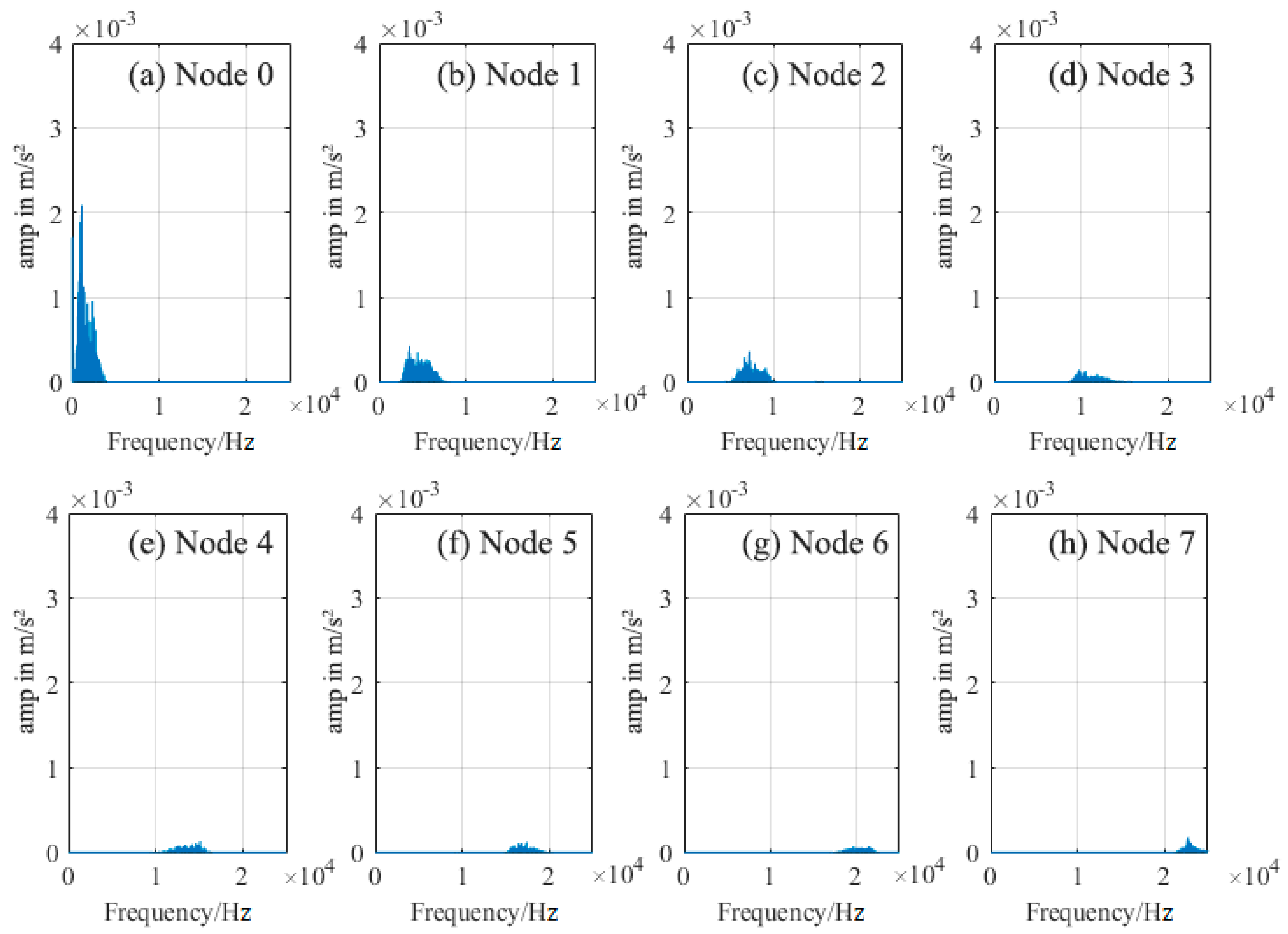

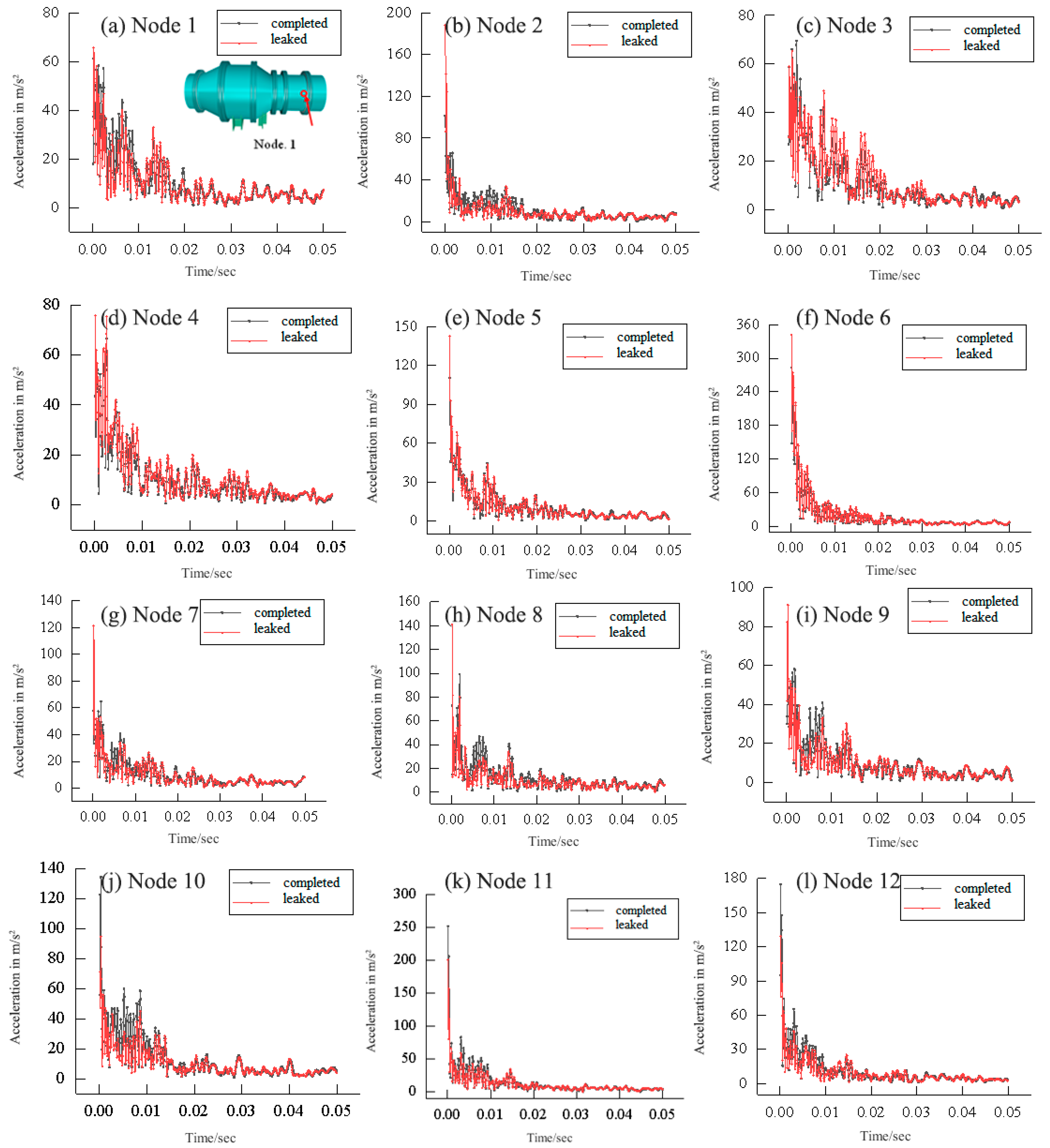


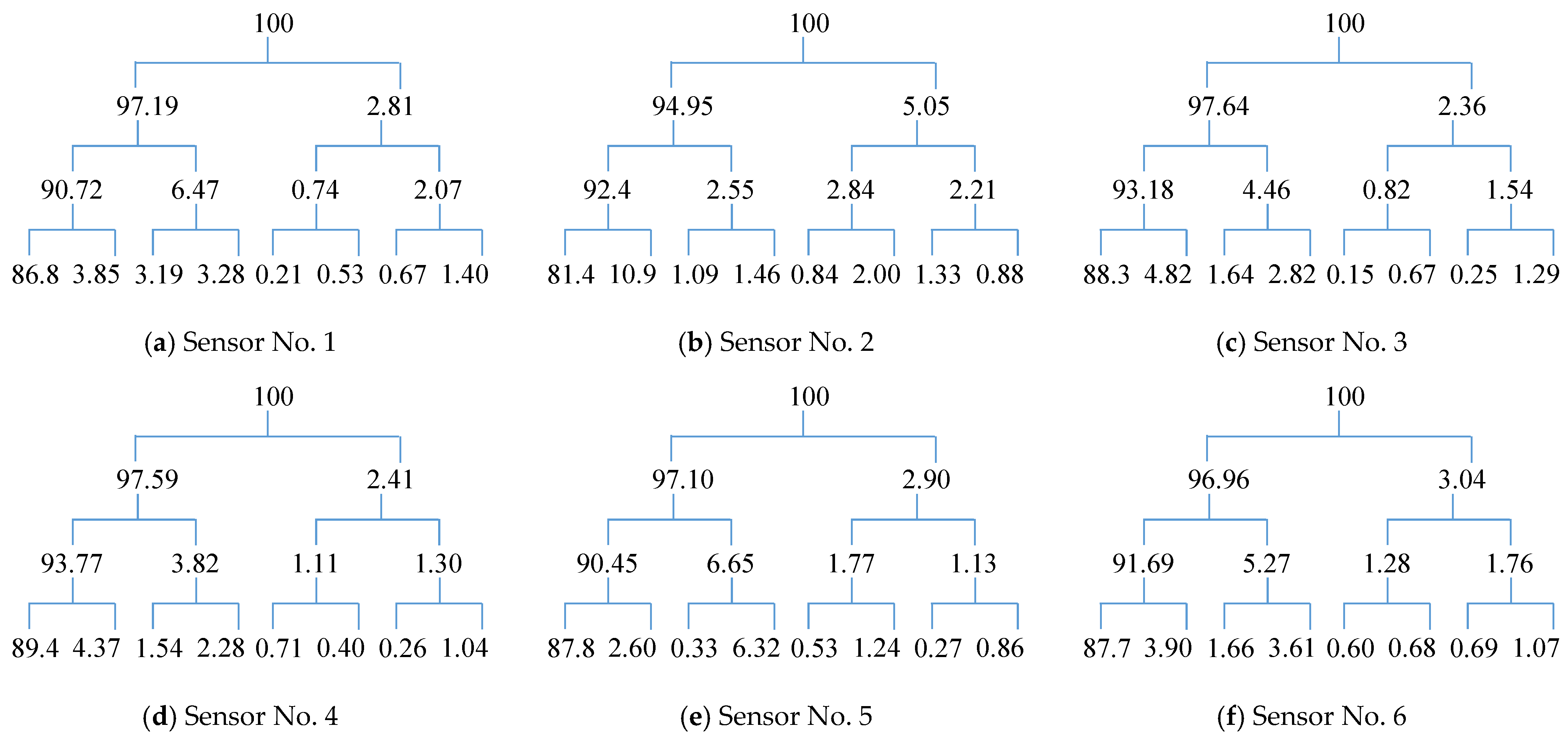
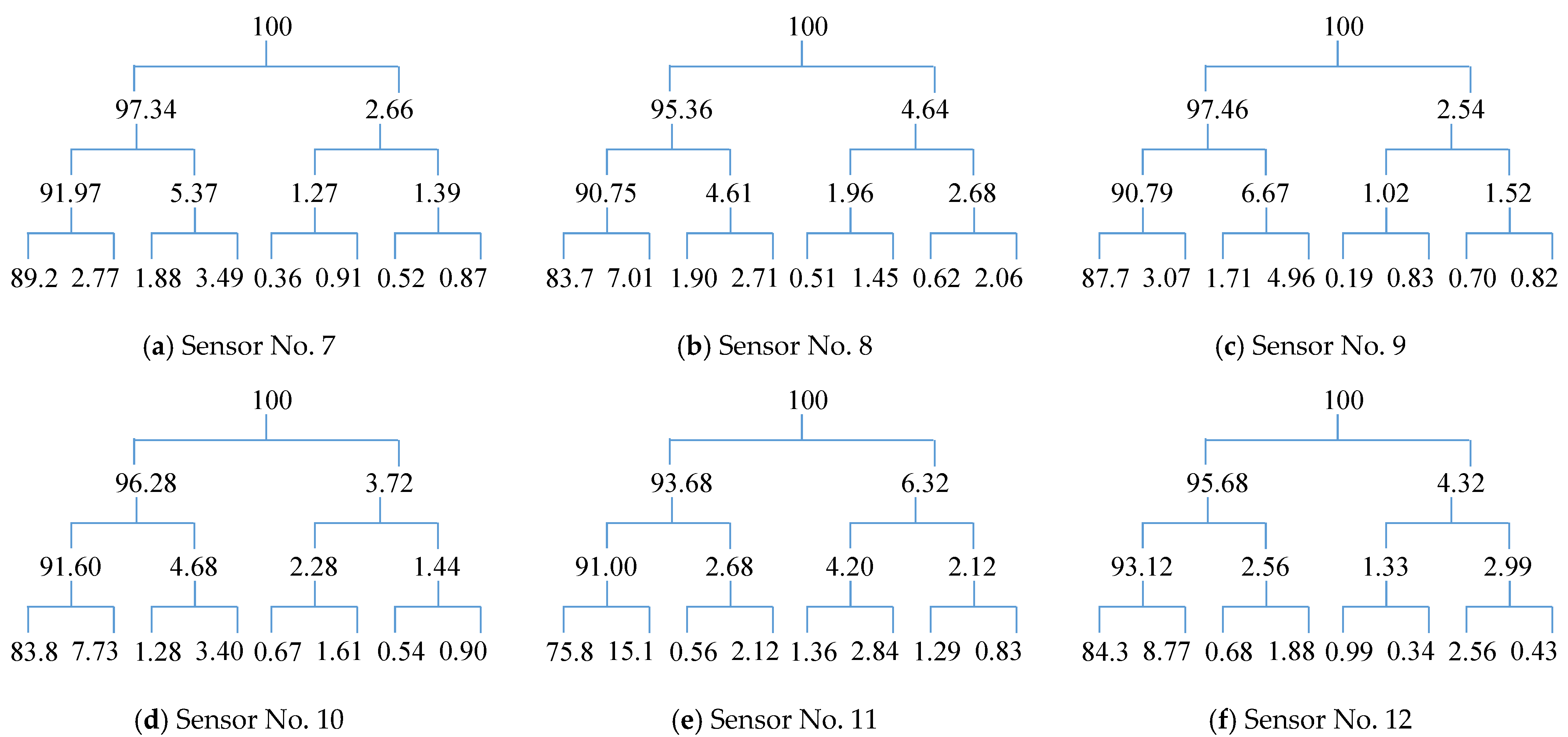
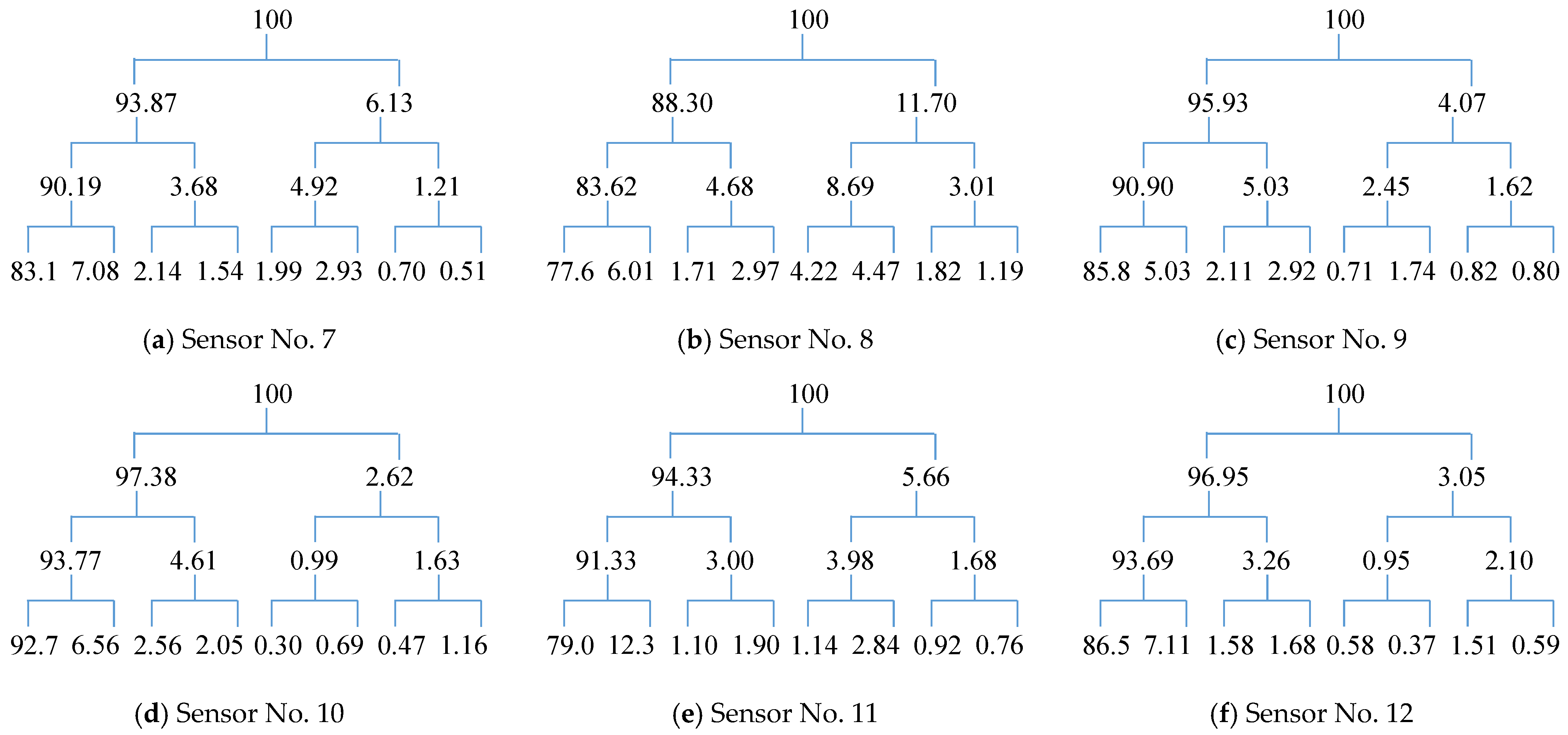
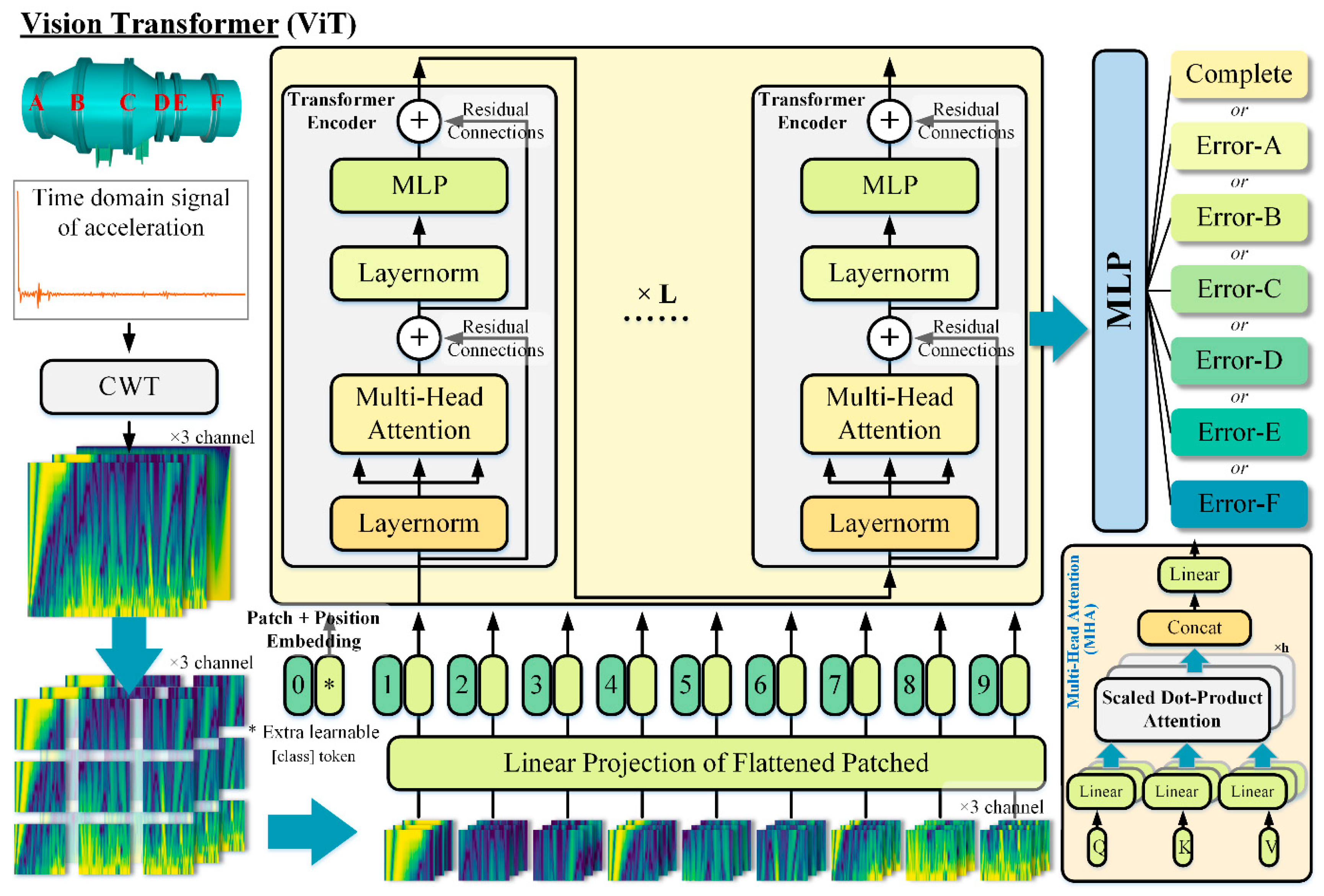

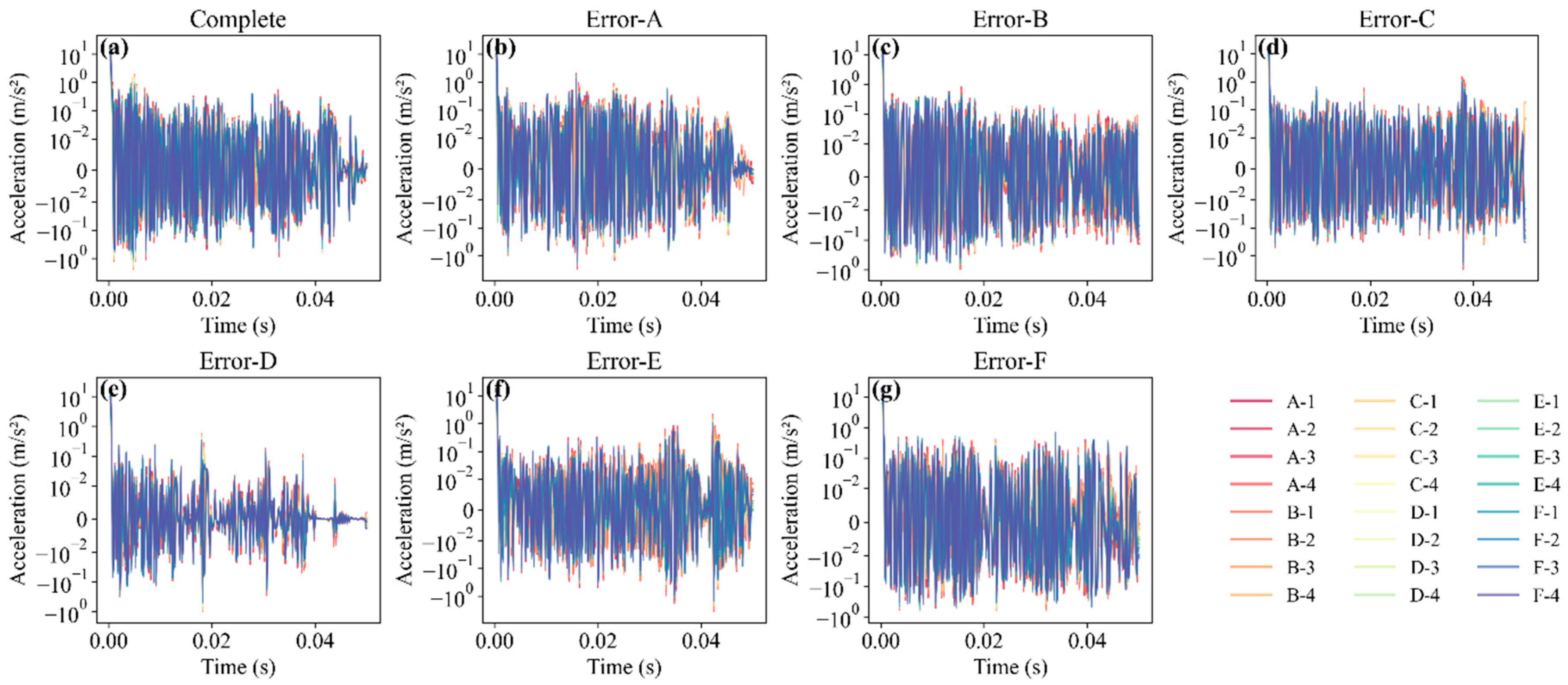

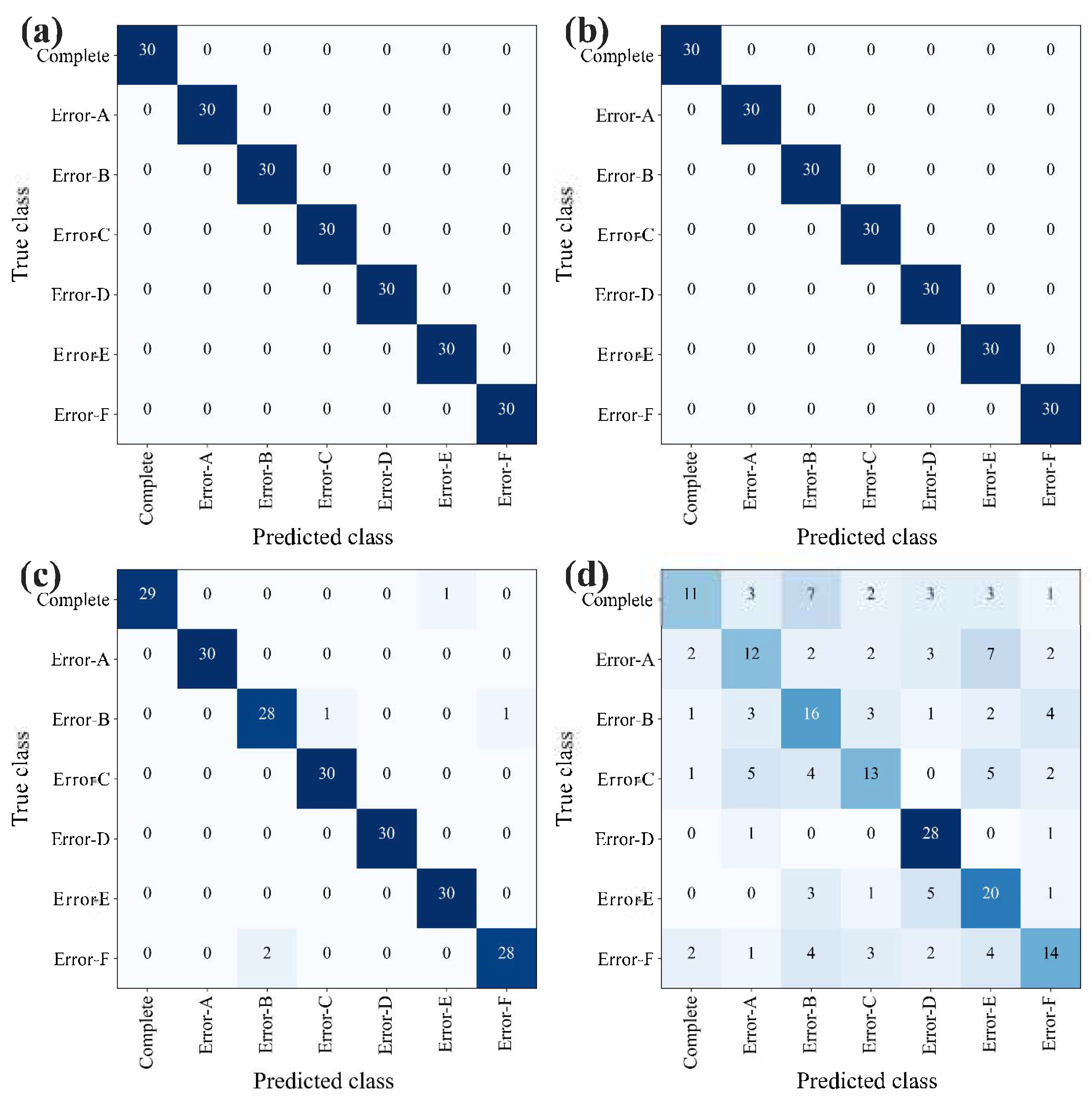

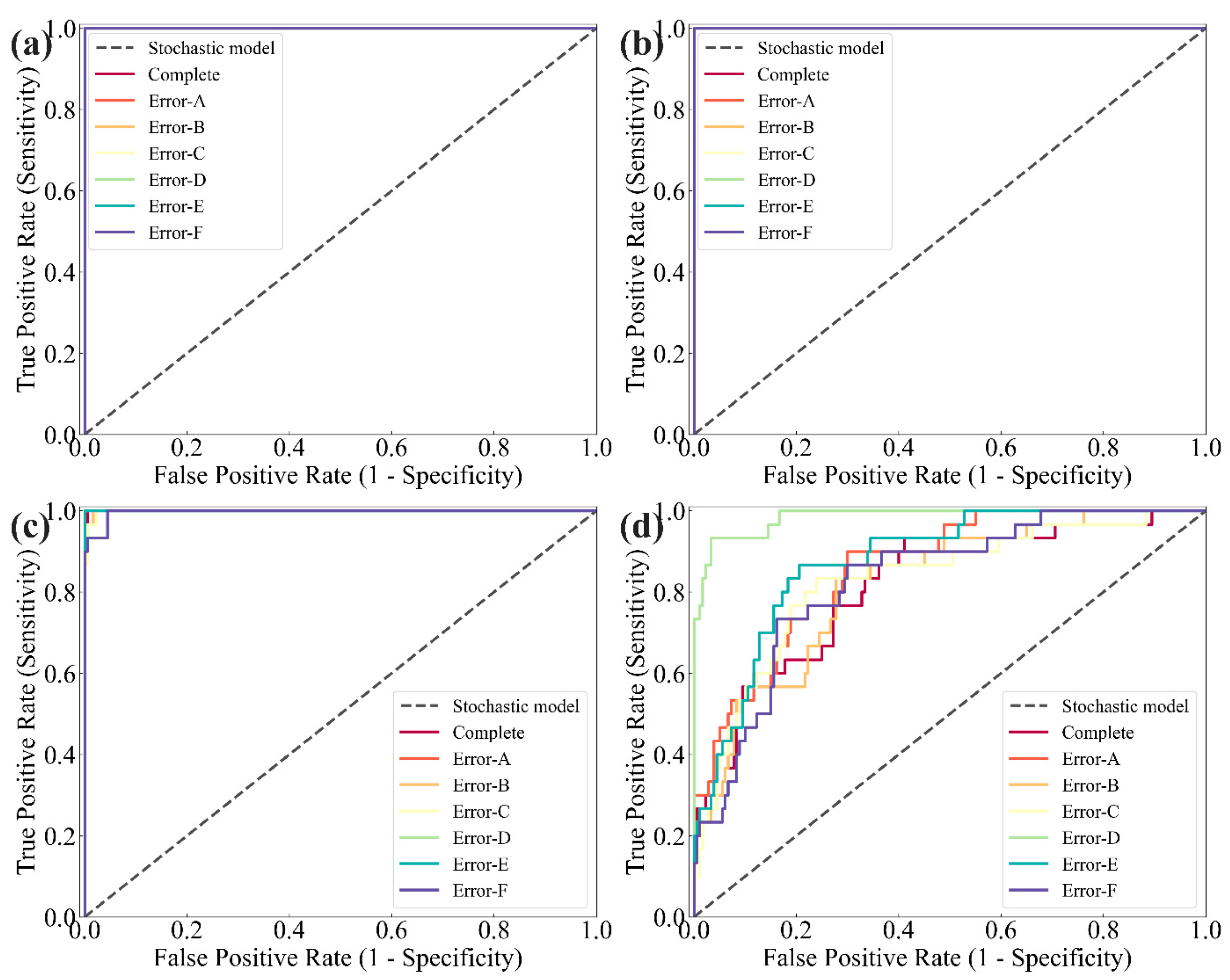
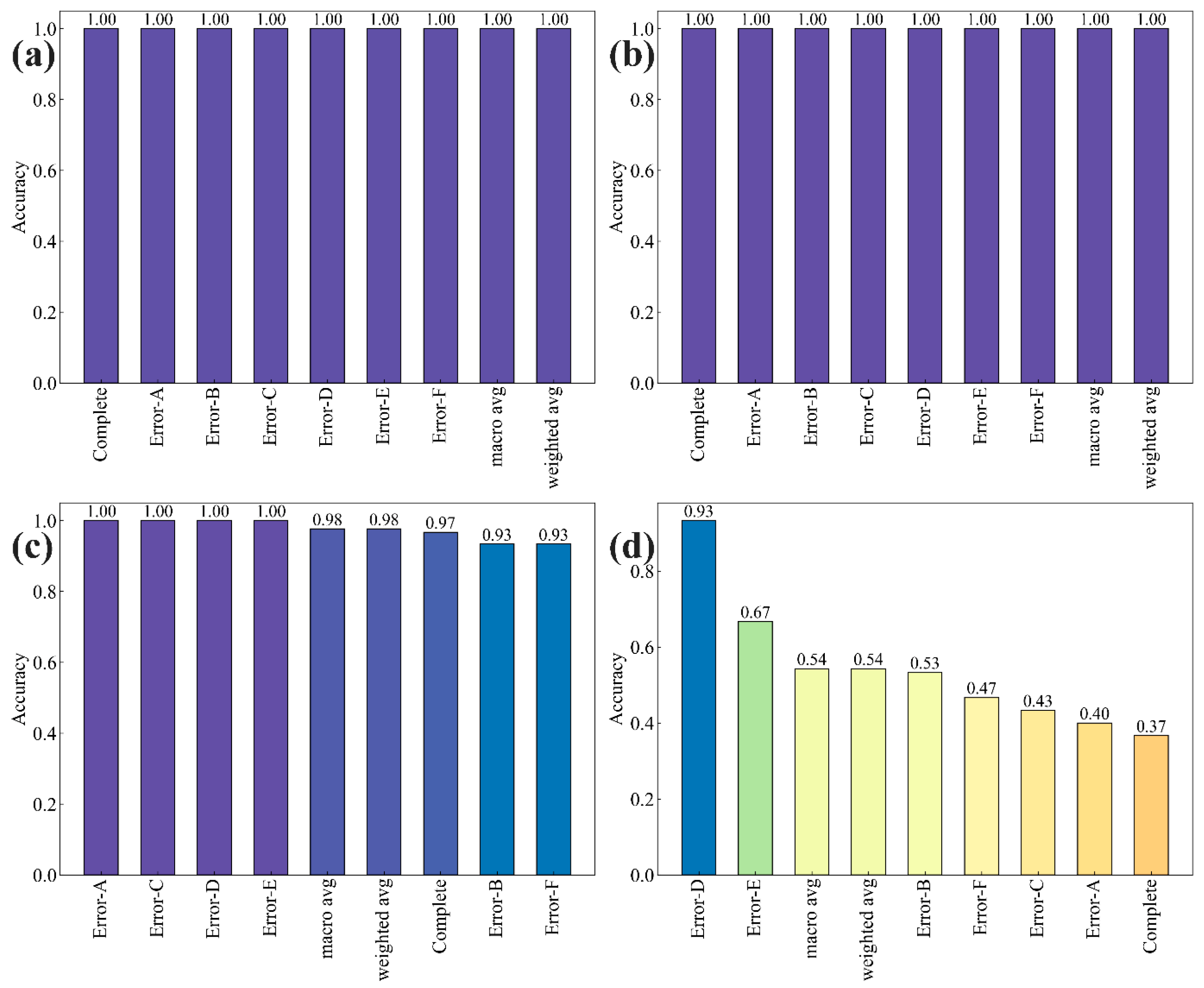
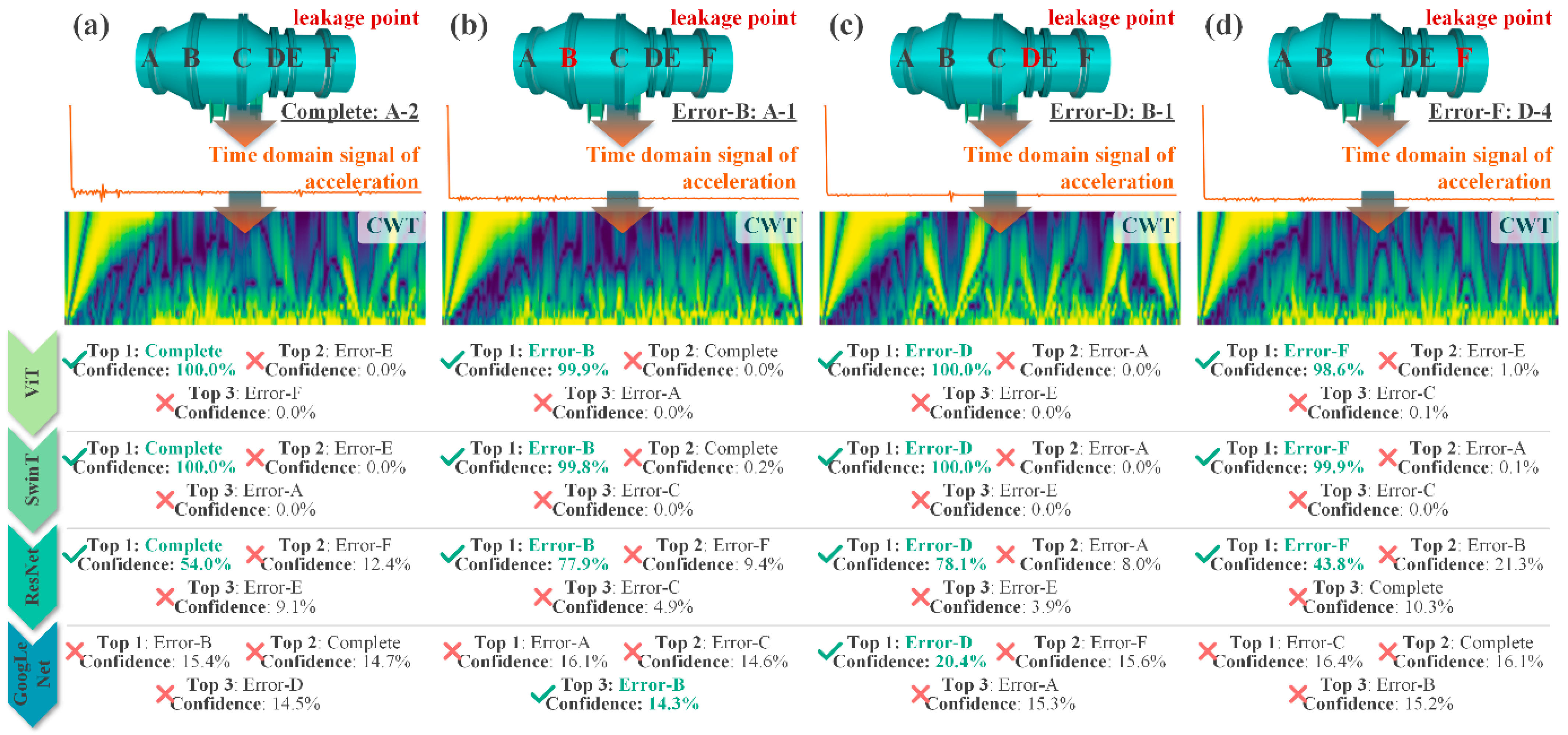
| Sensor Serial Number | 1 | 2 | 3 | 4 | 5 | 6 |
|---|---|---|---|---|---|---|
| Original energy signal | 8.7631 × 105 | 6.9843 × 105 | 1.0888 × 105 | 4.2159 × 104 | 4.4332 × 104 | 1.8108 × 105 |
| Percentage of maximum component energy (%) | 64.88 | 64.48 | 50.67 | 55.36 | 45.48 | 39.75 |
| Maximum component energy | 5.6853 × 105 | 4.5037 × 105 | 5.5167 × 104 | 2.3339 × 104 | 2.0163 × 104 | 7.1986 × 104 |
| Sensor Serial Number | 1 | 2 | 3 | 4 | 5 | 6 |
|---|---|---|---|---|---|---|
| Original energy signal | 1.1659 × 106 | 3.1434 × 106 | 5.8787 × 105 | 7.164 × 105 | 9.2515 × 105 | 1.3473 × 106 |
| Percentage of maximum component energy (%) | 59.92 | 87.85 | 56.93 | 59.89 | 58.36 | 45.81 |
| Maximum component energy | 6.9857 × 105 | 2.7616 × 106 | 3.3468 × 105 | 4.2906 × 105 | 5.3989 × 105 | 6.172 × 105 |
| Node Serial Number | 1 | 2 | 3 | 4 | 5 | 6 |
|---|---|---|---|---|---|---|
| Percentage of maximum component energy under leakage (%) | 89.47 | 87.12 | 88.71 | 88.30 | 88.96 | 88.46 |
| Percentage of maximum component energy without leakage (%) | 86.87 | 81.48 | 88.36 | 89.40 | 87.85 | 87.79 |
| Variation rate of maximum component energy (%) | 3.00 | 6.93 | 0.40 | −1.23 | 1.26 | 0.77 |
| Node Serial Number | 7 | 8 | 9 | 10 | 11 | 12 |
|---|---|---|---|---|---|---|
| Percentage of maximum component energy under leakage (%) | 89.20 | 83.74 | 87.72 | 83.87 | 75.83 | 84.35 |
| Percentage of maximum component energy without leakage (%) | 83.11 | 77.61 | 85.87 | 92.77 | 79.00 | 86.58 |
| Variation rate of maximum component energy (%) | 7.33 | 7.90 | 2.16 | −2.71 | −4.02 | 2.58 |
Disclaimer/Publisher’s Note: The statements, opinions and data contained in all publications are solely those of the individual author(s) and contributor(s) and not of MDPI and/or the editor(s). MDPI and/or the editor(s) disclaim responsibility for any injury to people or property resulting from any ideas, methods, instructions or products referred to in the content. |
© 2025 by the authors. Licensee MDPI, Basel, Switzerland. This article is an open access article distributed under the terms and conditions of the Creative Commons Attribution (CC BY) license (https://creativecommons.org/licenses/by/4.0/).
Share and Cite
Yi, F.; Zhong, R.; Zhu, W.; Zhou, R.; Wang, Y.; Guo, L. Leakage Fault Diagnosis of Wind Tunnel Valves Using Wavelet Packet Analysis and Vision Transformer-Based Deep Learning. Mathematics 2025, 13, 3195. https://doi.org/10.3390/math13193195
Yi F, Zhong R, Zhu W, Zhou R, Wang Y, Guo L. Leakage Fault Diagnosis of Wind Tunnel Valves Using Wavelet Packet Analysis and Vision Transformer-Based Deep Learning. Mathematics. 2025; 13(19):3195. https://doi.org/10.3390/math13193195
Chicago/Turabian StyleYi, Fan, Ruoxi Zhong, Wenjie Zhu, Run Zhou, Ying Wang, and Li Guo. 2025. "Leakage Fault Diagnosis of Wind Tunnel Valves Using Wavelet Packet Analysis and Vision Transformer-Based Deep Learning" Mathematics 13, no. 19: 3195. https://doi.org/10.3390/math13193195
APA StyleYi, F., Zhong, R., Zhu, W., Zhou, R., Wang, Y., & Guo, L. (2025). Leakage Fault Diagnosis of Wind Tunnel Valves Using Wavelet Packet Analysis and Vision Transformer-Based Deep Learning. Mathematics, 13(19), 3195. https://doi.org/10.3390/math13193195





